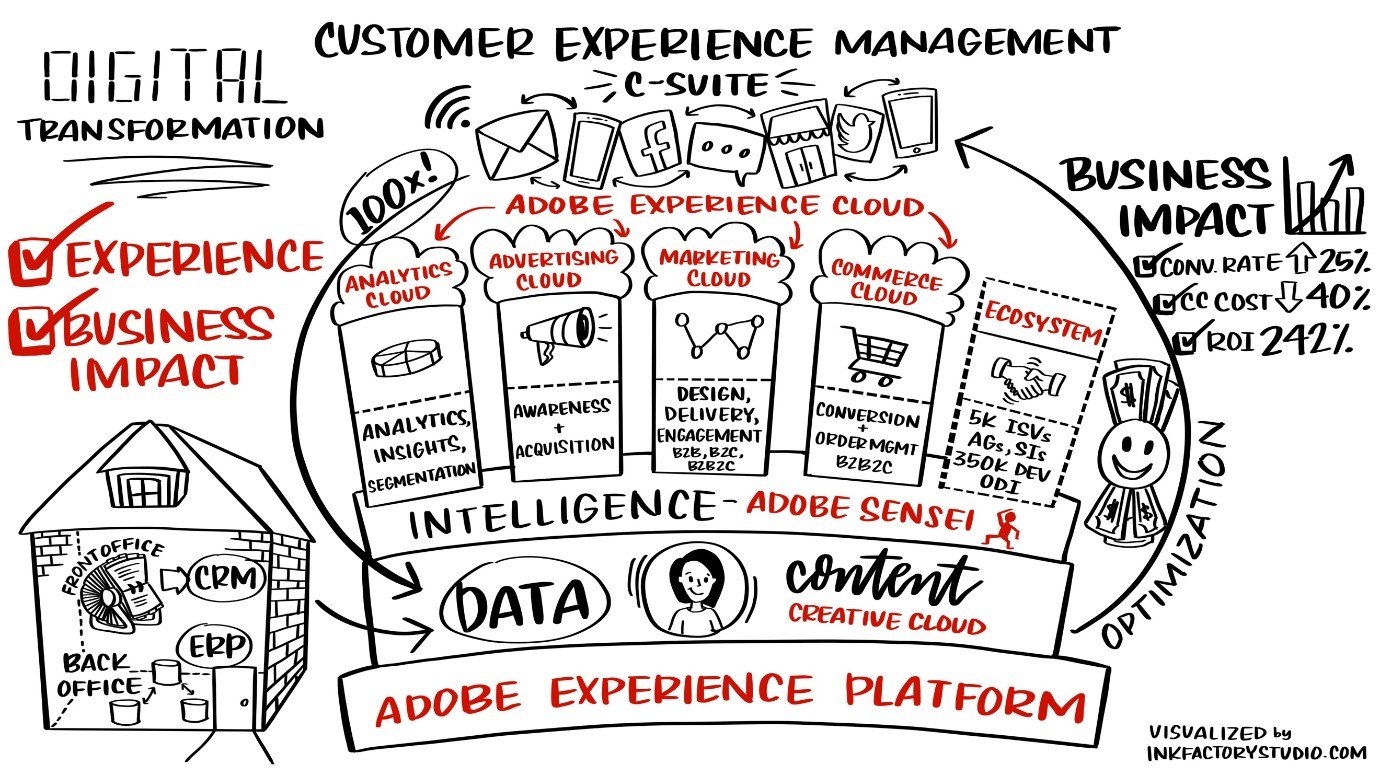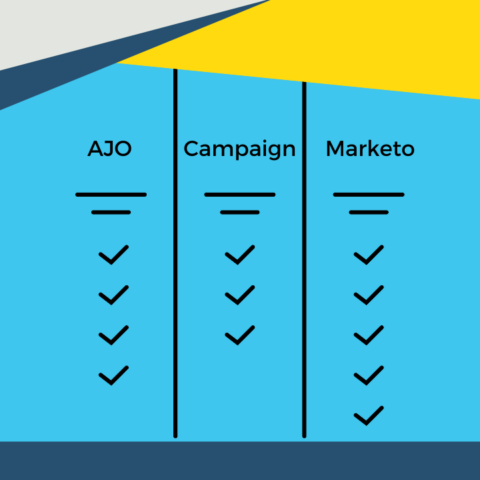
In 2019, the race for companies to create exceptional customer experiences will continue apace. By now, everyone is aware of the need for digital transformation, but a hot topic in board rooms as we enter 2019 is expected to be customer experience. And more specifically, how digital transformation can be leveraged to take customer experience to the next level. This will be achieved through Customer Experience Management.
Customers expect a lot from the modern company. To compete in this environment, you must strive to deliver exceptional experiences to your customers. This means putting customer experience at the core of your company. It needs to cover every interaction that your customers have with your brand. This is easy to write and easy for us to understand. However, it is incredibly difficult to achieve. Just ask Jeff Bezos. Exceptional customer experience is what has driven Amazon’s staggering growth over the last 10 years. Amazon revenue for the twelve months ending September 30, 2018 was $221B, a 37.11% increase year-over-year. That is up from just $70bn 5 years ago.
For the uninitiated, Customer Experience Management (otherwise referred to as CEM or CXM for those who love an acronym) is, according to Gartner, “the practice of designing and reacting to customer interactions to meet or exceed customer expectations and, thus, increase customer satisfaction, loyalty and advocacy”. It is a strategy that requires process change and many technologies to accomplish. In 2019 we can expect to see greater investment in customer experience management strategy and the formation of teams or councils to manage this area and to decide where budget should be spent.
So, what is required to be successful as an experience business? Let’s look at the five pillars of Customer Experience Management that are needed:
An open and real-time unified profile
Content velocity
Cross-channel orchestration
Intelligence
Ecosystem
To explore each pillar in turn…
Firstly, we need a profile. This is crucial to properly understand a customer using all the available data that exists across the organisation. Ideally, data should live in a single environment where solutions sit on top and read and write to the same environment. That environment should be open, connected to other systems in your organisation and available in real time.
Secondly, we need content. If you want to personalise experiences for customers, you need specific content. And you need to be able to deliver that content at scale; it could be for millions of visitors to your website a day. This presents a significant content pipeline challenge. Ideally, everyone in your organisation who is creating content should be able to push it into a content management system or digital asset management system and make it available to be pulled in real time.
Thirdly, we need to be able to orchestrate the delivery of the content across whatever channel the customer may consume it. The content needs to be delivered consistently to maintain brand credibility. To achieve excellence when managing cross-channel orchestration in today’s world, we need to be able to execute and optimise in milliseconds whilst maintaining context.
The first three pillars provide us with a foundation for Customer Experience Management.
The fourth, intelligence, should provide us with the ability to produce meaningful insights and predictions based on all the available data. This is where artificial intelligence and machine learning comes into play. Artificial intelligence (AI) is best used when it’s focused on a specific domain. That focus should be specific to your domain rather than trying to deploy a general AI framework. We need to be able to incorporate AI to analyse the vast amount of data available and to deliver insights that we can act on in real time.
Lastly, it is imperative that there is an ecosystem that allows you to connect all your systems, whether that’s a back-office system such as ERP or a front office CRM system. The philosophy should be to ensure an open ecosystem to allow certain systems to connect rather than trying to replace them.
What does the (near) future look like for customer experiences?
In 2019 we can expect to see more companies providing meaningful experiences to their customers through mediums such as augmented reality, voice recognition and virtual reality. Whilst leading companies will look to exploit these new channels, the reality is that most organisations are still some way off from being able to deliver meaningful customer experiences across the established channels in real-time, at scale and by acting on artificially intelligent insights.
There is significant value to be gained by those companies who can reach the nirvana of fully orchestrated customer experience management across all interactions in real-time. That means personalised experiences delivered to the customer based on real-time interaction data and real-time decision making based on those interactions. The best companies will be able create meaningful experiences at speed and at scale.
What technologies are available to help with Customer Experience Management?
Put simply, there are loads! Too many to cover in one article. Given that Customer Experience Management can impact the whole organisation, the technology that should be considered can cover everything from cross-channel campaign management, content creation, CRM, lead management, commerce, web content management, asset management, advertising, mobile, IoT, data management and the list goes on…
The main players in customer experience management technologies are Adobe, Salesforce, Oracle, SAP, IBM and Google. Along with some companies who will play in certain pillars of customer experience management; Sitecore, Acquia, Optimizely, Shopify, to name a few.
Over the last 5 years or so we have seen the evolution from Marketing Clouds to Digital Clouds and now to Experience Clouds. There has been a battle between Adobe, Salesforce and to a lesser extent IBM and others for a land grab at what is known as the enterprise level ($1bn+ turnover). The major players have been developing or acquiring software to deal with different aspects of customer experience management and we are now seeing the next stage in this evolution; the proper integration and automation across the tools in a single platform.
Adobe and Salesforce are now the two key competitors at the centre of digital transformation and artificial intelligence for corporate customers. IBM’s sale of some of its software including campaign management tool, Unica, to Indian company HCL Tech in December 2018 further substantiates this position. Adobe and Salesforce are likely to be two key contenders in the minds of the C-level when considering customer experience management technologies in 2019.
Adobe has made three key moves in 2018 that stand them in good stead for 2019. The first two are the acquisitions of Marketo and Magento. More on that later. The third is that back in September 2018, Adobe announced a strategic partnership between Adobe, Microsoft and SAP called the Open Data Initiative. The Open Data Initiative looks to address the issue of data silos. We all know that data is the ultimate thing that underpins all customer experiences in today’s world. The aim of the Open Data Initiative is to enable a seamless flow of connected customer data – behavioural, transactional, financial and operational – so companies get a true end-to-end view of their customers. The Open Data Initiative brings Adobe, Microsoft and SAP together to enhance interoperability and data exchange between their applications and platforms – Adobe Experience Cloud, Microsoft Dynamics 365, SAP C/4HANA and S/4HANA – via a common data model and data lake service on Microsoft Azure. The data model will provide a unified data store and allow customers to choose the tools and applications for the development and deployment of services.
The fact that Salesforce and Oracle are not part of the Open Data Initiative will surely put them at a disadvantage.
Meanwhile, Salesforce has continued its partnership with Google. This partnership is so far enabling customers to purchase Google Marketing Platform products directly from Salesforce in the US and Canada, they are enabling better connected data for Salesforce Sales Cloud and Google Analytics 360 integrations and they have improved some productivity integrations between Salesforce and Google Cloud. Salesforce have also launched Customer 360 following the acquisition of MuleSoft (a platform that is used to connect software via application programming interfaces), which aims to integrate all data and applications within an organisation via a Customer 360 ID.
The aims, then, for Adobe and Salesforce are similar; a world where their clients use all their applications and services to manage customer experience – whether B2C or B2B. The partnership between Adobe, Microsoft and SAP along with their acquisitions puts Adobe firmly in the driving seat for 2019.
So, back to those acquisitions and why they are important. Marketo and Magento. Marketo is a B2B marketing automation software and Magento is an ecommerce platform. With these acquisitions, the Adobe Experience Cloud is now the industry’s only end-to-end solution for content creation, marketing, advertising, analytics and commerce across B2C and B2B. And we shouldn’t ignore the Adobe Creative Cloud (including photoshop), which further enables content creation. Adobe is now able to cover those five pillars of customer experience management for B2C and B2B enterprises. It will of course take some time to fully integrate these tools, but the foundations are there to ensure they have a wider and more integrated offering than Salesforce.
Very few companies, if any, use the full offering of either Adobe or Salesforce. In reality, companies patch together the technology they have in the best way they can to deliver the best customer experiences they can. In future, it’s expected that companies will move towards using just one or a few platforms for customer experience management; hence the race we see between Adobe and Salesforce in this area.
Now that the case for Adobe has been made, that leads us on to the next question…
What exactly is the Adobe Experience Cloud and how can you use it to achieve customer experience management excellence?

The Adobe Experience Cloud is the name given to the collection of Adobe tools that are used to manage customer experiences. Within the Adobe Experience Cloud there are sub-clouds: Adobe Analytics Cloud, Adobe Advertising Cloud, Adobe Marketing Cloud and Adobe Commerce Cloud. The tools within these are explained further in the table below.
| Cloud | Tools | How the tools are used |
| Adobe Analytics Cloud | Adobe Analytics
|
To understand all experience-centric data, to extract insights and do segmentation (Adobe Analytics). These insights need to be made available across your organisation and used to predict business (Audience Manager). The tools should be used to create the common source of truth for targeting and performance measurement.
|
| Adobe Audience Manager | ||
| Adobe Advertising Cloud | Adobe Advertising | To build brand, create awareness, and acquire customers.
Adobe Advertising is used to manage advertising across all channels, including traditional TV, social, display, and search.
|
| Adobe Marketing Cloud | Adobe Experience Manager
|
To design and deliver great experiences that engage customers through their desired path.
Whether you’re engaging with customers in a B2C setting (Adobe Campaign), or with businesses in a B2B setting or even B2B2C (Marketo) – you will want to optimise the experiences (Adobe Target) across all channels to ensure customers receive exceptional experiences.
This will include managing your assets (i.e. content) and personalising your website and apps (Adobe Experience Manager).
|
| Adobe Campaign | ||
| Adobe Target | ||
| Marketo | ||
| Adobe Commerce Cloud | Magento
|
To convert your customers and handle their order management – again B2C, B2B, and B2B2C, across industries. This could be a shopping cart transaction, or maybe signing a contract or mortgage.
|
And what is the Adobe Experience Platform?
The tools described above within the Adobe Experience Cloud can sit on top of the Adobe Experience Platform, which is otherwise referred to as the Adobe Cloud Platform. I know, it can get confusing!
The Adobe Experience Platform is the data foundation for customer experience management and the way companies will act on data from the Open Data Initiative. This is where data, content, intelligent services, and an open ecosystem come together. It’s where you enhance customer experiences, deliver real-time personalisation, and act on data. The platform organises data from all sources, structuring it into a common data model and creating a unified profile, while supporting a content pipeline via Adobe Creative Cloud that organises and makes content available for millisecond delivery.
The rationale behind the Adobe Experience Platform is that there are four key factors preventing enterprises from building their own experience platform:
Existing enterprise systems were not designed to handle high volume, high velocity data required to provide the necessary customer insights
Companies struggle to normalise data across these disparate systems. This crucial step is needed before data from different sources can be analysed to provide a complete and unified customer profile.
Many enterprises lack the skills and capabilities to apply advanced analysis techniques such as machine learning and artificial intelligence to enrich customer profiles with actionable insights.
Experiences happen in real-time. An Experience Platform needs to be able to roundtrip data and insights within milliseconds to personalise customer experiences in the moment.
Therefore, Adobe have built a platform that provides a way for enterprises to achieve customer experience management excellence without having to build and maintain their own platform.
The features of the Adobe Experience Platform are further explained in the table below.
| Feature | Explanation |
| Data ingestion | Use Adobe Experience Platform Data Ingestion to batch and stream data from Adobe solutions and third parties. |
| Adobe Experience Platform Launch | Tag and SDK management. Adobe Experience Platform Launch lets you collect data and deploy applications across your sites and mobile apps. |
| Adobe Experience Platform Auditor | Scan up to 100 pages at once to inspect your Adobe implementations, while including or excluding pages as needed. Generate reports that score your Adobe implementations based on tag presence, configuration, and consistency. |
| Location service | Location-Based Data Processing. Adobe Experience Platform Location Service makes it easy to process and use location data to create targeted, geography-based experiences. |
| Standardised data | Experience Data Model creates a standard data schema for Adobe and partners to use across all data types. |
| Data governance | With Adobe Experience Platform Governance, you can easily label data, so everyone can use it effectively. |
| Privacy control | Adobe Experience Platform GDPR Service includes an API and a user interface to process GDPR requests and delete requests. |
| SQL query tool | With Adobe Experience Platform Query Service, you can perform complex, omnichannel analysis of your data. |
| Flexible data model creation | Using the plug-and-play power of Adobe Experience Platform Data Science Workspace, you can create any data model to meet your company’s needs. |
| AI and machine learning (Adobe Sensai) | Adobe Sensei taps into the power of AI and machine learning to offer robust attribution, customer profiling, content services, and more. |
| Unified customer profile | With Adobe Experience Platform Unified Profile you have a single profile built from all your data and that reflects what’s happening in real time for better targeting and personalized experiences. |
| Real-time segmentation | The Adobe Experience Platform Segmentation Service allows you to take advantage of connected data from all sources and unified profile. Create powerful, usable segments in real time. |
| Identity control | Market to people not devices using Adobe Experience Platform Identity Services, a device-linking service for people-based experience management. |
Adobe are in beta testing for integrating the Experience Cloud with the Experience Platform, which has seen Adobe Campaign as the first tool integrated by the end of 2018. Other tools in the Experience Cloud will follow in 2019. The first use cases for Adobe Campaign will be send time optimisation and fatigue management utilising machine learning from Adobe Sensei. However, a word of warning for Adobe Campaign Classic users; the integration is only available for Campaign Standard.
What value or business benefits can you expect?
Forrester Research recently completed a Total Economic Impact study for a set of customers across industries and geographies that have invested in Adobe Experience Cloud and the results include the following business impact:
25% average increase in conversion rate
40% average reduction in service centre call volume
242% average Return on Investment (ROI) over 3 years
These are just a few of examples of the metrics that are driven by Adobe Experience Cloud.
And how much does all of this cost?
Costs will vary from business to business. There is no set rate for an Adobe Experience Cloud and/or Adobe Experience Platform package. As an indication, you can expect a minimum spend of $100k for a package consisting of Adobe Experience Manager 6.4 or above, Adobe Analytics and Adobe Target for companies with $100m-$1bn total turnover. That’s for the licences – you can expect an additional 1-2 times the licence cost for implementation. Adobe have some punchy growth targets in 2019, so it is expected that there are some deals to be had for companies looking to invest in multiple areas of the Adobe stack.
What will TAP be doing in 2019 to help clients with Customer Experience Management?
As I’ve mentioned previously, most existing Adobe clients only use a few of the Adobe tools within the Experience Cloud. In 2019, the expectation is that a greater number of businesses will be using more of the Adobe stack and starting to look at the Experience Platform to see how they can get the most from the technology they have invested in.
TAP is investing to ensure that we can continue to help our clients by providing technical expertise across the Adobe Experience Cloud and Adobe Experience Platform. In particular, we are broadening our expertise with Analytics, AI, machine learning and Marketo to help clients leverage these capabilities.
As our clients expand their requirements across the Adobe Experience Cloud, we will be available to provide expertise or to point you in the right direction. We recognise that no one company will be able to deliver end-to-end customer experience management services. Strategic partnerships will be needed. We are therefore exploring partnerships with other agencies to ensure we can add as much value to our client engagements as possible. So, watch this space!
Whether you need assistance putting together a business case, want to see how you could be getting more from the Adobe stack or you’re just plain confused about the options and want to talk it through, then I’d be happy to hear from you.
To contact James, drop him an e-mail here.
Read more from the our Archives



